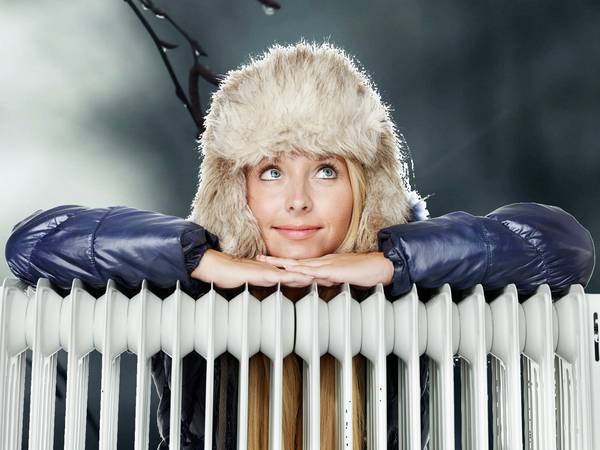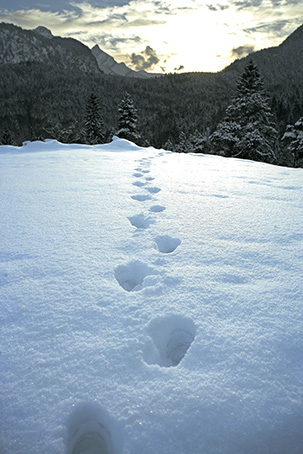It affects women in particular: While their partner complains about the "bull heat" in the room, they prefer to put on one more sweater. Room temperatures as low as 20° C make them shiver. They rarely leave the house without hats, gloves and thick stockings, even in the transitional period. What is behind this particular sensitivity?
Basic principles

Humans have a body temperature of 37°C, every child knows that. However, this is a great simplification. In fact, there is not one temperature in the body, but many.
37°C prevails only in the body core, i.e. in the most important organs such as the heart, kidneys, liver or brain. However, their share in the body weight is small - about 10%. Muscles and skin, on the other hand, make up more than 50%. Together with arms and legs, they are usually referred to as the body shell. Their temperature is subject to strong fluctuations. When it is cool outside, the body protects itself from cold loss by lowering the temperature in the shell. When exercising, on the other hand, the muscles can heat the body up to 39°C.
In addition, the values fluctuate during the day. At night they drop by almost one degree and in the afternoon they rise to values around 37.8 °.
An unclothed person feels most comfortable at 29-30°C, a temperature that prevails during the day in the cradle of humanity in East Africa.
Large span
Even if the temperature fluctuates by almost 2° during the day, the range in which we can survive is not very wide. If the fever is above 42°, there is a loss of consciousness and a collapse of the circulation. Above 43° at the latest, the protein coagulates. Below 27°, death threatens in torpor of cold. Only a few people can survive even lower core temperatures unharmed.
Although most people find cold much more unpleasant, the cold tolerance of humans is thus much higher (10° and more) than the heat tolerance (maximum 5°).
More cold sensors than hot sensors
Temperature regulation is monitored by about 30,000 cold receptors and 3,000 heat receptors. These nerves are found all over the body, particularly densely in the face, especially around the mouth. The sensors pass their information on to the brain, where it is further processed. The set point is determined by the thalamus. As a rule, this is 37° C core temperature. In the case of dangerous infections, the setpoint temperature is increased, and fever is the result.
The thalamus then gives commands to the autonomic nervous system to initiate the necessary corrections if the measured temperature deviates from the setpoint.
Control from the very top

The thalamus gives commands to the autonomic nervous system to initiate the necessary corrections when the measured temperature deviates from the set point.
If the temperature is too low, there is:
- Sensation of cold, freezing, shivering.
- shivering, in extreme cases chills
- Constriction of the skin vessels, goose bumps
- Redistribution of blood flow, temperature of arms and legs decreases
If temperature is too high, there is
- sensation of warmth, feeling of heat
- Increase in blood flow to the skin with accompanying reddening of the skin,
- improvement of blood circulation of arms and legs
- Sweating
Shivering factors
Freezing and also feeling hot are therefore warning signals that prompt the body to take appropriate countermeasures. Whether we feel cold depends not only on the outside temperature, but also on other factors:
- Thickness of the fat layer
- Body weight
- Thickness of the skin
- Training condition
- Muscle mass
- Habituation, mood (anxiety, insecurity)
- Hormones (thyroid, sex hormones)
- Blood pressure
- Nervous system disorders (e.g. diabetes)
- Numerous diseases
- Pain
- Lack of sleep
Freeze as protection
Freezing and also a feeling of heat are therefore warning signals that prompt the body to take appropriate countermeasures. In extreme cold or heat, all reserves are mobilized. Stress hormones (cortisone, adrenaline, noradrenaline) are released to restore the threatened balance.
In people who tend to freeze, this stress reaction sets in very early. This explains the feeling of fear and threat, as the body reacts as if something life-threatening is about to happen. For these people, a series of cold-damp days can be a real stress. As a result of the stress, fatigue, susceptibility to infections and exhaustion then occur.
Women and men
There are often ridiculed differences between men and women. Women actually freeze much more easily. Although they have thicker subcutaneous fatty tissue, their skin is nevertheless thinner than that of men. This means that the sensitive cold receptors are located more densely under the skin and trigger a cold stimulus more easily. At the same time, men on average have more muscles that produce a lot of heat even when at rest. Finally, women are on average lighter and thus have a relatively larger surface area, which leads to additional heat loss.
Habituation or avoidance
Habituation or avoidance
But dealing with cold can also be learned. An unclothed person feels most comfortable at 29-30°C, a temperature that prevails during the day in the cradle of mankind in East Africa. In the northern regions, we need clothing. At the same time, we have also adapted to the cold in the course of settling these latitudes. Eskimos have mastered this. They already appreciate the mild breeze at a shady 8°C and feel that a short shirt is appropriate clothing. At the same temperature, an inhabitant of Africa still needs a cap and gloves.
Disadvantage of central heating

Since the invention of central heating and air conditioning, ever lower demands have been placed on the body's own thermoregulation. According to the motto "you snooze, you rust," the fine-tuning of temperature regulation loses some of its capabilities. Thus, people who are always in uniformly heated or temperate environments freeze more.
In earlier times, it was probably not very comfortable to go back and forth between the well-heated kitchen and the cold parlors, but for temperature regulation this was optimal training. Within a day, the skin and muscle blood flow adapted dozens, maybe hundreds of times.
So, in addition to the lack of movement, for us humans today there is a lack of cold and warm stimuli.
So why do some people freeze while others are always comfortably warm? As can be seen from the above, several factors usually come together. Very essential seems to be the general training condition, the ratio of muscles to fat tissue, fear and the habituation to the cold.
Those who feel themselves to be "frostbite" will avoid the cold, heat well and dress warmer. As understandable as this mode of reaction is, nothing worsens thermoregulation more than this form of sparing. Systematic avoidance of the cold does not train the interaction of nerves, hormones and vessels. The system loses competence, the regulation becomes worse and the tolerance to cold decreases. A vicious circle! Avoidance of cold is the surest way to maintain abnormal sensitivity.
Thus we see women who freeze so badly that they can only leave the house in certain mild weather conditions, without wind, without direct sunlight.
Freezing and anxiety
Cold feet!
Fear often gives you the proverbial cold feet. How come. Two factors seem to be particularly important here.
- Increased perception of cold stimuli
- Increased counter-regulation of the body as protection against cooling down
Perception amplification
Our body constantly receives information from a wide variety of sensors. Pain, pressure, touch, cold and heat sensors flood the central nervous system with "status messages".
"In the left second toe on the underside in the middle there is currently a temperature of 36.5° C" could be such a status message. This is not exactly exciting, since such a temperature corresponds to the normal value. So this information is hidden. Also the fact that just stockings and shoes are worn, is in the normal case little interesting and does not reach therefore into the consciousness.
But it is different when signals have a meaning. It is already enough when you think of your toes that you may feel a slight tingling there. In short: Signals enter the consciousness when they have a meaning.
If cold is perceived as threatening, it is perceived more intensely than if it is evaluated as insignificant. The worst is when cold is associated with fear. "Maybe I'll freeze to death!" "Maybe I'll catch pneumonia!" Such fears automatically increase the perception.
Counter regulation
What does the body do when cold is dangerous? It tries to minimize heat loss. To do this, the unimportant areas of the body get less blood flow: feet, hands, legs, arms and generally the body shell. All the blood is directed to the important internal organs and the brain. The result is ice-cold feet, hands, legs or buttocks.
Night freezing
Marion, a 34-year-old patient reported the following observation to me. She tends to get very cold and always dresses nice and warm. However, she also freezes terribly at night. However, not always. She freezes especially when her husband is on a business trip. Although the temperature in the bedroom has not changed, she just can't get warm, even with two blankets. As soon as her husband returned, she no longer needed the double blanket. The man did not hold her in his arms all the time. It is simply enough when he lies next to her. Even when he was only in the apartment, she was already warm in bed.
Therapy

Cold training is at the forefront of the therapy. Actively dealing with the cold is the best way to overcome hypersensitivity. This is difficult at first, and of course it is considered an imposition to go out in winter when you are already shivering all over.
It is easier if you warm up first and then go out into the cold. This can be done, for example, by taking alternating showers: At the beginning really hot, then ice cold. The sauna also works on this principle. The positive effect comes mainly from the abrupt cooling down after the sweat bath. The cold plunge pool or the dousing shower is important.
Sauna without cooling is not very therapeutic. Here, the vessels are only maximally dilated. The actual training effect, the maximum conscious constriction, is missing.
Exercise in nature, where you can feel the cold, also promotes temperature regulation.
Warming thoughts
The evaluation of the cold therefore decides to a significant extent how the body reacts. Therefore, it can be useful to take away your own fear of the cold. This can be done by changing one's inner attitude. Instead of perceiving the cold as threatening, it can also be seen as refreshing, invigorating or activating. It can make you wonderfully clear-headed.
Perhaps you once remember what it was like as a child when the first snow fell and you were looking forward to being able to go sledding. Not a trace of freezing! Just get out quickly!
This will be even more effective if you combine it with a real experience. So step outside in the freezing cold, lightly clothed, and "enjoy" the cold. At the beginning only briefly, then longer.
Cold chamber against freezing
The most intensive regulation training imaginable is the direct change from an infrared chamber (approx. +80°C) to a cold chamber (approx. -80°C) with which we treat patients. Due to the huge temperature jump, the regulatory system is trained to the maximum. Only through the pre-treatment with heat, even very shivery people are able to overcome the fear of the unearthly cold air.
All these findings are not new. Father Kneipp discovered the beneficial effects of cold water as early as the middle of the 19th century, when he succeeded in curing his tuberculosis by bathing daily in the cold Danube. From this he developed the highly recommended treatments named after him.
Anyone who exercises regularly in this way will experience surprisingly rapid results within a few weeks. The excessive sensitivity to cold subsides. Studies have shown that the production of stress hormones in response to cold is then significantly lower. The body deals with the frosty outside temperatures more calmly.

